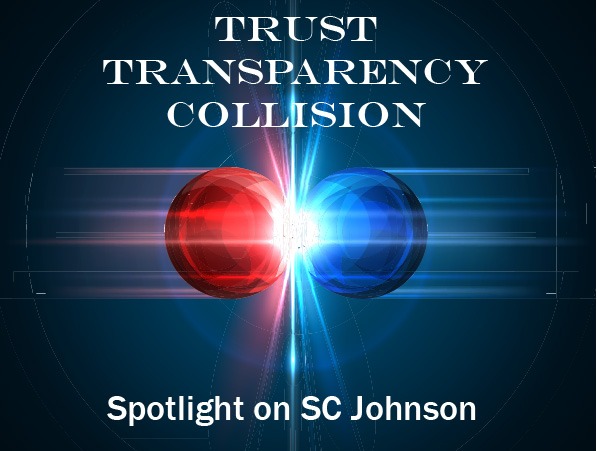 At Trust Transparency Center, we actively seek out best practices in corporate activity that support our premise that the proactive exercise and commitment to Trust Transparency has high ROI across many measurements. We also seek examples of trust transparency collisions. One recent example of a collision can be found in the BrandChannel Q & A with the CEO of the SC Johnson Company Fisk Johnson, published several weeks ago entitled Trust in Transparency: 5 Questions With SC Johnson CEO Fisk Johnson.
At Trust Transparency Center, we actively seek out best practices in corporate activity that support our premise that the proactive exercise and commitment to Trust Transparency has high ROI across many measurements. We also seek examples of trust transparency collisions. One recent example of a collision can be found in the BrandChannel Q & A with the CEO of the SC Johnson Company Fisk Johnson, published several weeks ago entitled Trust in Transparency: 5 Questions With SC Johnson CEO Fisk Johnson.
First of all, we do applaud the candor and approach evident in this piece, which indicates the company absolutely recognizes that transparency is a journey, that the words ‘trust’ and ‘transparency’ are inextricably linked and that consumers need much more education on so many levels in order to truly understand what they consume and what’s in the products they buy. The interview, though, illustrates the challenges a company can face, especially a chemical company in today’s ‘environment’– while trying to do the right thing. We see in this interview an example of cross-purpose or inconsistency we can find ourselves in when we try to judge the relative merits of natural versus sustainable. We also see at least two attempts at consumer education that arguably misfire.
The Trust Transparency Collision
When you are fundamentally a chemical company, even a family facing chemical company, and consumerism has led to such a solid negative perception of chemicals (even those as necessary and household-familiar as cleaning products) even starting the journey to Trust Transparency can be daunting. And SC Johnson started ten years ago. Hallmarks of the program include last May’s disclosure of 368 skin allergens with allergens listed on a product-specific basis, a move ahead of current regulatory requirements. And the company was early, in its embrace of additional transparency. The most current update from April, notes that this past fall, the company expanded its ingredient transparency program to the Asia Pacific region and has made progress in reducing its environmental footprint – achieving zero manufacturing waste to landfill status at more than 65 percent of its manufacturing facilities, ahead of schedule in meeting its goal to send zero manufacturing waste to landfill from its factories by 2021.
Many ‘chemical’ and manufacturing companies are facing similar paths with some just getting underway in the last 24 months. Recognizing the journey needs to start somewhere and being prepared to take bold steps is a requirement. Being able to make decisions without the constant pressure of public markets is an advantage. These are all good things.
Here’s where the challenges start. Even with SC Johnson’s over-arching initiative and communication plan including the recent interview, perceived inconsistencies often catch the spotlight. In this case, many consumers just don’t understand chemistry and chemicals. The company tries to deal with that reality by describing as chemicals the naturally-occurring constituents of a banana and comparing it with a chemical product formula and its constituents. Referencing banana constituents as Prop 65 harmful substances may be misleading and risks alienating some consumers who would want to support the company’s initiatives.
In the second ‘collision’ instance, trying to explain, as Johnson does, that “the tox(icity) profile of Windex is not that dissimilar from water, but people perceive Windex as a chemical bad thing,” will predictably raise an avoidable, immediate response from skeptics who again would otherwise support SC Johnson’s transparency journey.
We understand what the company is trying to achieve and it’s got a difficult message to communicate. The two analogies they’ve chosen do not advance their journey. Instead of this disconnect, we, reading the interview, should be clearly motivated, supportive and appreciative of the conclusion, “We view transparency as one important way we continue to build and maintain trust in our company and brands”. Avoiding challengeable justifications would be a better approach.
~Len






